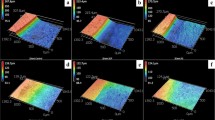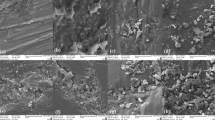Abstract
This study aimed to compare the mean mineral density difference (mMDD) and surface morphology of 10- and 60-s silver diamine fluoride (SDF)-applied dentin carious lesions and to study the effect of an additional 20-s light curing (LC) on SDF-treated teeth. Forty primary molar blocks with natural dentin carious lesions were measured for baseline lesion depth and mineral density using Image-Pro Plus software. The samples were randomly distributed into 4 groups; 38% SDF applied for 1) 10-s (10SDF), 2) 60-s (60SDF), 3) 10-s + LC (10SDF + LC), 4) 60-s + LC (60SDF + LC) and an additional control group to assess the outcome of pH-cycling only. Then all the groups underwent a 7-d bacterial pH-cycling. The dentin carious lesions’ mMDD was determined by digital subtraction radiographic analysis. The surface morphology and elemental profile were assessed by scanning electron microscopy and energy-dispersive X-ray spectroscopy. The mMDD of the dentin lesions was analyzed using two-way ANOVA, generalized linear models analysis. Light curing was the only factor that affected the mMDD (p = 0.007). The mMDD in the 10SDF + LC and 60SDF + LC groups were significantly higher than those without light curing (p = 0.041 and 0.041, respectively). The 60SDF + LC group demonstrated a significantly higher mMDD than the 10SDF group (p = 0.010), while that in the 10SDF + LC group was similar to the 60SDF group (p = 1.00). Scanning electron microscopy revealed denser mineral content layers, which were likely silver and chloride, in the 10SDF + LC and 60SDF + LC groups than in the 10SDF and 60SDF groups, respectively. In conclusion, shortened application time with light curing enhanced SDF remineralization similarly to the conventional method.







Similar content being viewed by others

Availability of data and materials
The datasets used and/or analyzed during the current study are available from the corresponding author on reasonable request.
References
Chu CH, Lo EC. Promoting caries arrest in children with silver diamine fluoride: a review. Oral Health Prev Dent. 2008;6(4):315–21. https://doi.org/10.3290/j.ohpd.a14177.
Crystal YO, Niederman R. Silver diamine fluoride treatment considerations in children’s caries management. Pediatr Dent. 2016;38(7):466–71.
Mei ML, Ito L, Cao Y, Li QL, Lo EC, Chu CH. Inhibitory effect of silver diamine fluoride on dentine demineralisation and collagen degradation. J Dent. 2013;41(9):809–17. https://doi.org/10.1016/j.jdent.2013.06.009.
Mei ML, Lo ECM, Chu CH. Arresting dentine caries with silver diamine fluoride: what’s behind it? J Dent Res. 2018;97(7):751–8. https://doi.org/10.1177/0022034518774783.
Castillo JL, Rivera S, Aparicio T, Lazo R, Aw TC, Mancl LL, et al. The short-term effects of diammine silver fluoride on tooth sensitivity: a randomized controlled trial. J Dent Res. 2011;90(2):203–8. https://doi.org/10.1177/0022034510388516.
Chairside Guide: Silver diamine fluoride in the management of dental caries lesions. Pediatr Dent. 2018;40(6):492–517.
Mei ML, Ito L, Cao Y, Lo EC, Li QL, Chu CH. An ex vivo study of arrested primary teeth caries with silver diamine fluoride therapy. J Dent. 2014;42(4):395–402. https://doi.org/10.1016/j.jdent.2013.12.007.
Toopchi S, Bakhurji E, Loo CY, Hassan M. Effect of light curing on silver diamine fluoride in primary incisors: a microscopic ex vivo study. Pediatr Dent. 2021;43(1):44–9.
Crystal YO, Marghalani AA, Ureles SD, Wright JT, Sulyanto R, Divaris K, et al. Use of silver diamine fluoride for dental caries management in children and adolescents, including those with special health care needs. Pediatr Dent. 2017;39(5):135–45.
Eberhard J, Hartman B, Lenhard M, Mayer T, Kocher T, Eickholz P. Digital subtraction radiography for monitoring dental demineralization. Caries Res. 2000;34(3):219–24. https://doi.org/10.1159/000016594.
Phonghanyudh A, Ruangdit C, Pornprasertsuk DAS, Phanthumvanit P. Subtraction radiographic assessment of underlying dentin after partial carious dentin removal in primary teeth. Oral Health Prev Dent. 2017;15(6):575–9. https://doi.org/10.3290/j.ohpd.a38996.
Ricketts DN, Ekstrand KR, Martignon S, Ellwood R, Alatsaris M, Nugent Z. Accuracy and reproducibility of conventional radiographic assessment and subtraction radiography in detecting demineralization in occlusal surfaces. Caries Res. 2007;41(2):121–8. https://doi.org/10.1159/000098045.
Guimarães Mdo C, Passanezi E, Sant’Ana AC, Grechi SL, Taba JM. Digital subtraction radiographic analysis of the combination of bioabsorbable membrane and bovine morphogenetic protein pool in human periodontal infrabony defects. J Appl Oral Sci. 2010;18(4):379–84. https://doi.org/10.1590/S1678-77572010000400010.
Shi XQ, Li G. Detection accuracy of approximal caries by black-and-white and color-coded digital radiographs. Oral Surg Oral Med Oral Pathol Oral Radiol Endod. 2009;107(3):433–6. https://doi.org/10.1016/j.tripleo.2008.07.008.
Klein U, Kanellis MJ, Drake D. Effects of four anticaries agents on lesion depth progression in an in vitro caries model. Pediatr Dent. 1999;21(3):176–80.
Fontana M, Dunipace AJ, Gregory RL, Noblitt TW, Li Y, Park KK, et al. An in vitro microbial model for studying secondary caries formation. Caries Res. 1996;30(2):112–8. https://doi.org/10.1159/000262146.
Delgado AJ, Olafsson VG. Acidic oral moisturizers with pH below 6.7 may be harmful to teeth depending on formulation: a short report. Clin Cosmet Investig Dent. 2017;9:81–3. https://doi.org/10.2147/CCIDE.S140254.
Carneiro LS, Nunes CA, Silva MA, Leles CR, Mendonca EF. In vivo study of pixel grey-measurement in digital subtraction radiography for monitoring caries remineralization. Dentomaxillofac Radiol. 2009;38(2):73–8. https://doi.org/10.1259/dmfr/15857365.
Babaahmadi V, Montazer M, Toliyat T, Ghanbarafjeh M. Photochemical reduction of silver nitrate to nano silver using stannous chloride, CTAB and daylight irradiation. Nanomater Appl Prop. 2011;1(part1):183–90.
Sayed M, Matsui N, Hiraishi N, Inoue G, Nikaido T, Burrow MF, et al. Evaluation of discoloration of sound/demineralized root dentin with silver diamine fluoride: in-vitro study. Dent Mater J. 2019;38(1):143–9. https://doi.org/10.4012/dmj.2018-008.
Hou W-C, Stuart B, Howes R, Zepp RG. Sunlight-driven reduction of silver ions by natural organic matter: formation and transformation of silver nanoparticles. Environ Sci Technol. 2013;47(14):7713–21. https://doi.org/10.1021/es400802w.
Hu P, Cao Y. A new chemical route to a hybrid nanostructure: room-temperature solid-state reaction synthesis of Ag@AgCl with efficient photocatalysis. Dalton Trans. 2012;41(29):8908–12. https://doi.org/10.1039/C2DT30779K.
Suzuki T, Nishida M, Sobue S, Moriwaki Y. Effects of diammine silver fluoride on tooth enamel. J Osaka Univ Dent Sch. 1974;14:61–72.
Lansdown ABG. Silver I: its antibacterial properties and mechanism of action. J Wound Care. 2002;11(4):125–30. https://doi.org/10.12968/jowc.2002.11.4.26389.
Mei ML, Nudelman F, Marzec B, Walker JM, Lo ECM, Walls AW, et al. Formation of fluorohydroxyapatite with silver diamine fluoride. J Dent Res. 2017;96(10):1122–8. https://doi.org/10.1177/0022034517709738.
Yu OY, Zhao IS, Mei ML, Lo ECM, Chu CH. Caries-arresting effects of silver diamine fluoride and sodium fluoride on dentine caries lesions. J Dent. 2018;78:65–71. https://doi.org/10.1016/j.jdent.2018.08.007.
Seto J, Horst JA, Parkinson DY, Frachella JC, DeRisi JL. Enhanced tooth structure via silver microwires following treatment with 38 percent silver diamine fluoride. Pediatr Dent. 2020;42(3):226–31.
Lau L, Quock RL, Wu DI, Harrington DA, Patel SA, Barros JA. Effect of surface preparation and light curing on penetration of silver particles from 38% silver diamine fluoride in dentin of primary teeth: an in vitro evaluation. Am J Dent. 2021;34(1):44–8.
Duangthip D, Chu CH, Lo ECM. A randomized clinical trial on arresting dentine caries in preschool children by topical fluorides—18 month results. J Dent. 2016;44:57–63. https://doi.org/10.1016/j.jdent.2015.05.006.
Clemens J, Gold J, Chaffin J. Effect and acceptance of silver diamine fluoride treatment on dental caries in primary teeth. J Public Health Dent. 2018;78(1):63–8. https://doi.org/10.1111/jphd.12241.
Mei ML, Li QL, Chu CH, Lo EC, Samaranayake LP. Antibacterial effects of silver diamine fluoride on multi-species cariogenic biofilm on caries. Ann Clin Microbiol Antimicrob. 2013;12:4. https://doi.org/10.1186/1476-0711-12-4.
Acknowledgements
The authors thank Dr. Kevin Tompkins, the scientists at the Department of Microbiology, Oral Biology Research Center, and Dental Material Research and Development Center, Faculty of Dentistry, Chulalongkorn University and the scientists at Dental Biomaterial Analysis and Research Center, Faculty of Dentistry, Mahidol University for their assistance in our study.
Funding
This research was supported by the 90th Anniversary of Chulalongkorn University Fund under Grant GCUGR1125633027M from Chulalongkorn University, Thailand.
Author information
Authors and Affiliations
Corresponding authors
Ethics declarations
Conflict of interest
The authors declare that they have no conflict of interest.
Ethical approval
All experimental protocols were performed in accordance with the Declaration of Helsinki. The study protocols were approved by the Human Research Ethics Committee (HREC-DCU 2020–008) and Institutional Biosafety Committee (DENT CU-IBC 007/2020) of the Faculty of Dentistry, Chulalongkorn University.
Informed consent
Each child’s legal guardian donated the extracted teeth for the research purpose of this study. Informed consents were obtained for all teeth.
Additional information
Publisher's Note
Springer Nature remains neutral with regard to jurisdictional claims in published maps and institutional affiliations.
Rights and permissions
Springer Nature or its licensor (e.g. a society or other partner) holds exclusive rights to this article under a publishing agreement with the author(s) or other rightsholder(s); author self-archiving of the accepted manuscript version of this article is solely governed by the terms of such publishing agreement and applicable law.
About this article
Cite this article
Karnowakul, J., Punyanirun, K., Jirakran, K. et al. Enhanced effectiveness of silver diamine fluoride application with light curing on natural dentin carious lesions: an in vitro study. Odontology 111, 439–450 (2023). https://doi.org/10.1007/s10266-022-00755-z
Received:
Accepted:
Published:
Issue Date:
DOI: https://doi.org/10.1007/s10266-022-00755-z



